When an explosives-laden car driven by a militant ambushed a convoy driving paramilitary men who were to resume their duties in Srinagar, 49 personnel were killed and scores are fighting injuries. The unprecedented attack quickly pushed Kashmir into a crisis. As the cries for revenge get high-pitch in the government and on the streets, Kashmir is again a new bad TV story, reports Muhammad Younis
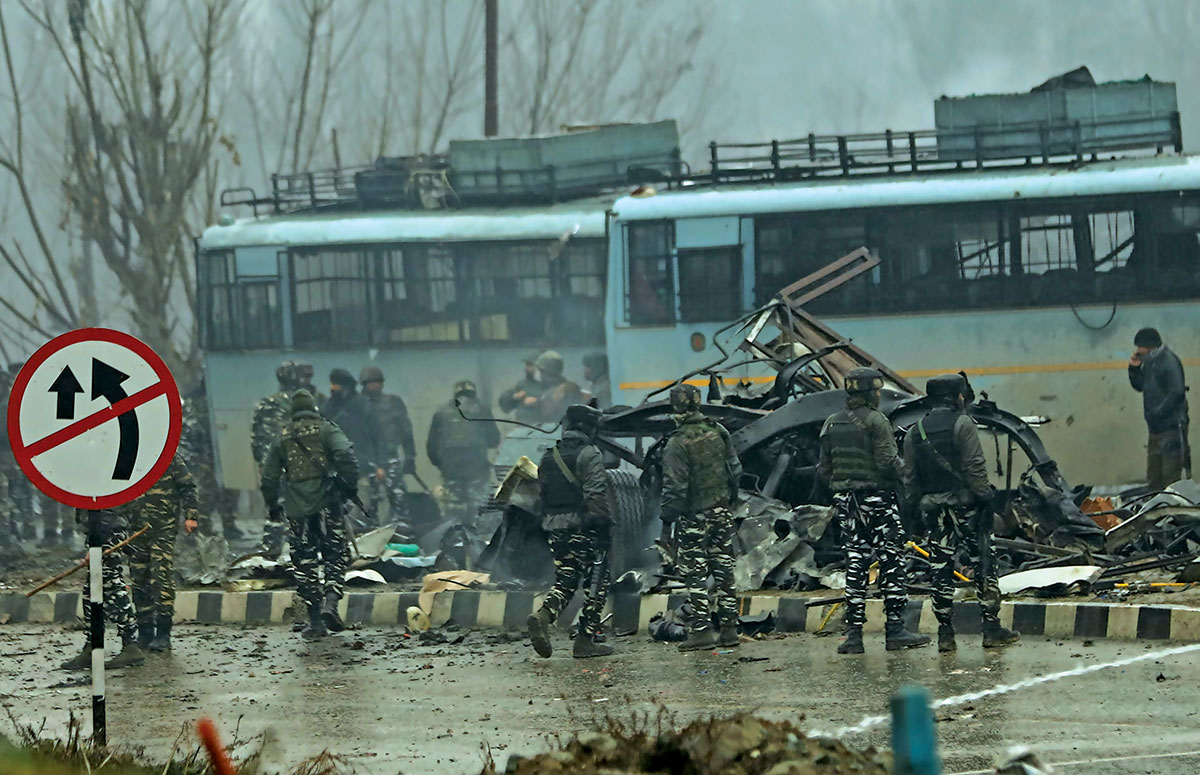
On Friday morning, at the Kashmir’s arterial highway to Jammu, near the Higher Secondary Lethapora, a fairly large mixed contingent of counter-insurgent forces had gathered near the spot where 49 CRPF personnel were killed in an unprecedented car bomb attack a day before. Almost 20 hours after the attack, there lay debris of the ill-fated convoy vehicles, a mangled heap of iron, and a lot of gloom and tense air.
On one side, the shutter of a shop among a line was bent behind repair. Shreds of clothes still hung over on the electric lines overhead. The glasses of the destroyed vehicles were scattered on the road. Through the wreckage, the police, however, was trying to manage a smooth passage of traffic.
Cops manning the road were not allowing anyone to come near the spot. A group of media men were waiting at a safe distance to be permitted to do their professional duty; a team of National Investigation Agency (NIA) was to visit the spot, collect the samples for forensic examination and do whatever they might require for probing the biggest attack ever.
Away from the spot, people from neighbouring areas had gathered before shop fronts. Azhar (name changed), one among the gathering, recalled what actually had happened the previous day.
Azhar said he was sitting in a chair on the slab of his dry fruit shop when an “extremely” loud bang distracted him from deep thought. Since, there was a shutdown call already given by the separatists – which was called off later – not much traffic was plying on the highway, snaking before his shop. He barely had a customer. So instead of sitting idle in the shop, he had gone upstairs.
Less than a minute before the blast took place, a convoy of Central Reserve Police Forces (CRPF), coming from Jammu towards Srinagar, began to go vroom before Azhar’s shop. The fleet was about half a kilometre in length. Going up the road – from Azhar’s shop, the road slopes up towards the famous Saffron Karewas. As the front end of the convoy was about to fade before his eyes, the blast took place.
“I could see the broken pieces of the CRPF bus going as high as the Airtel tower,” Azhar said, pointing towards the tower, which sits on a hillock bordering one side of the spot and overlooks a vast space. “No one knows from where the attacker came. As far as we know, the forces are on constant guard along the national highway when a convoy passes by, and for security, they even stop other vehicles for its smooth passage.”
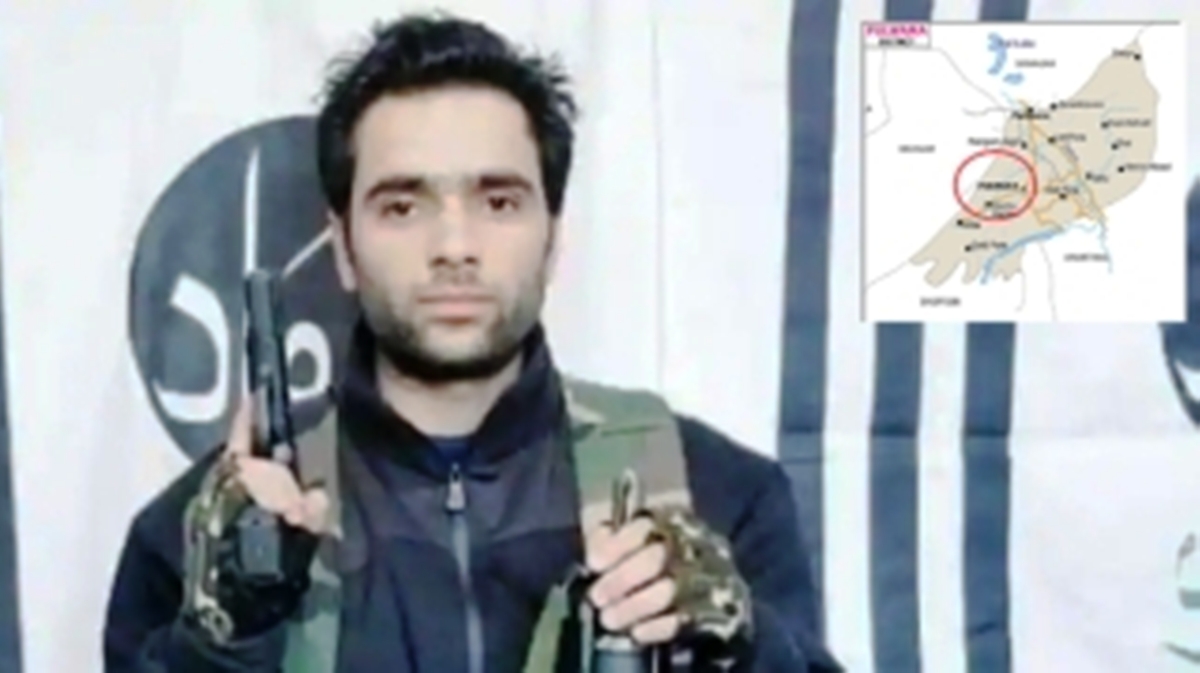
The intensity of the blast could be gauged from the fact that almost 500 meters away, a Registration Certificate (RC ) belonging to one of the slain CRPF personnel from the blown-out vehicle was collected by a local in the courtyard of his house. Almost every house in the vicinity had got the damage of some sort. “The inner walls of some of the houses have got cracks, and almost the window glasses of every house in the village have been broken,” said a resident, wishing to stay anonymous. The bang had been so loud that even in Srinagar, more than a dozen kilometres away, it was heard.
The gatherings at different places on the road dared not to go near the spot. Rashid, another local, said he was collecting wood planks in the courtyard of his house in Lethpora’s Pethpora Mohalla at the time of the blast. “When I ran out on the road to find what it was, I saw huge plumes of smoke going up in the air.”
Rashid said the locals understood it was a crisis and might have tried to come out and help the CRPF in evacuating the injured to the hospital quickly. “But as we saw people being beaten up, nobody attempted to take any risk,” he said.
It was insecurity all around. Within moments after the deafening explosion, some of the shopkeepers, in main market Lethapora, ran away after shutting their stores, some didn’t get that time even, and left their shops open, in the care of none. “Some of the shops are still open,” one resident said on the day next.
Azhar said that after pulling down the shutters of his shop, he maintained a constant vigil on the situation. Immediately after the blast, he said, a volley of bullets could be heard, “but I’m sure it was not the CRPF, because, for about 10 minutes, they didn’t come out of their vehicles.”
A while after the firing stopped, he said, the CRPF personnel came out of their vehicles and took positions, whoever was around was hauled up and beaten. “A paramedic and another person who was repairing a tower had been ruthlessly beaten up,” Azhar said, he was told. Some of them started to assemble the corpses. Later, they were joined by the personnel from the Group Centre CRPF Lethapora.
After a brief halt, the convoy was directed to have a U-turn and drive to the Victor Force headquarters. By then, the troops and the police had arrived on the scene.
The situation started getting clearer later. The convoy was basically ferrying more than 2,500 CRPF in around 78 vehicles. “The personnel were returning from leave to re-join their duties but once they reached near the Higher Secondary School in Lethpora, a vehicle driven by a militant rammed into the bus and it blasted,” said a top police official.
A CRPF official said two vehicles took the car bomb impact – one carrying 44 personnel and another one with 39 men. The men belonged to various battalions: 92, 17, 54, 82, 61, 21, 98, 118, 76, 45, 03 and 176. “While none from the bus carrying 44 CRPF men survived, five of the injured among those travelling in another bus have also succumbed,” the officer said. All the injured were evacuated to the 92-Base hospital in Srinagar’s 15 Corps Headquarters.”

Moments after the attack, militant outfit Jaish-e-Muhammad (JeM) staked the claim for the attack and identified the militant, who rammed his vehicle into the convoy, as Aadil.
A resident of Gundibagh, Kakapora, Adil had joined JeM in March 2018, months after he dropped-out of twelfth standard and a local Madrassa. Before joining militancy, he worked as a mason and used to lead prayers in a local Masjid to support his family. Earlier in June, his family was in the news when they claimed they survived a nocturnal bid on their home.
Before the attack, a video of Adil surfaced on social networking sites in which he is speaking for 10.10 minutes and calling the attack as ‘revenge’. Adil, 21, is survived by his father Ghulam Hassan Dar, who sells cloth on his cycle by going door-to-door, his mother and two more brothers.
Fearing retribution from the forces, the locals in the immediate neighbourhood said soon the dusk fell, they left their homes and took refuge at their relatives living in other places. Some of the families, living nearby the spot, were, however, asked by the forces to vacate and leave their houses open for their (forces) night’s stay.
Going by the quantum of explosives used and the number of casualties it caused, the Lethpora car bomb blast is considered to be the biggest ever car bomb attack by militants ever. Everybody condemned the attack. Even the JRL said they regret every killing on the soil of Kashmir. From Washington to Moscow, the condemnations came from everywhere.
“The United States condemns in the strongest term the terrorist attack today on an Indian Central Reserve Police Force envoy in the Indian state of Jammu and Kashmir,” US State Department deputy spokesman Robert Palladino said in a statement. “We extend our deepest condolences to the victims and their families and wish a speedy recovery to those injured. The United States is resolutely committed to working with the Indian government to combat terrorism in all its forms. The UN designated Pakistan based terrorist group Jaish-e-Muhammad has claimed responsibility for this heinous act. We call on all countries to uphold their responsibilities to UN security council resolutions to deny safe haven and support for terrorists.”
As Home Minister Rajnath Singh took off for Srinagar to meet the security grid and be part of the Friday wreath-laying event at the CRPF’s Srinagar Centre, Prime Minister Narendra Modi presided over the Cabinet Committee on the Security Affairs, the highest decision-making body.
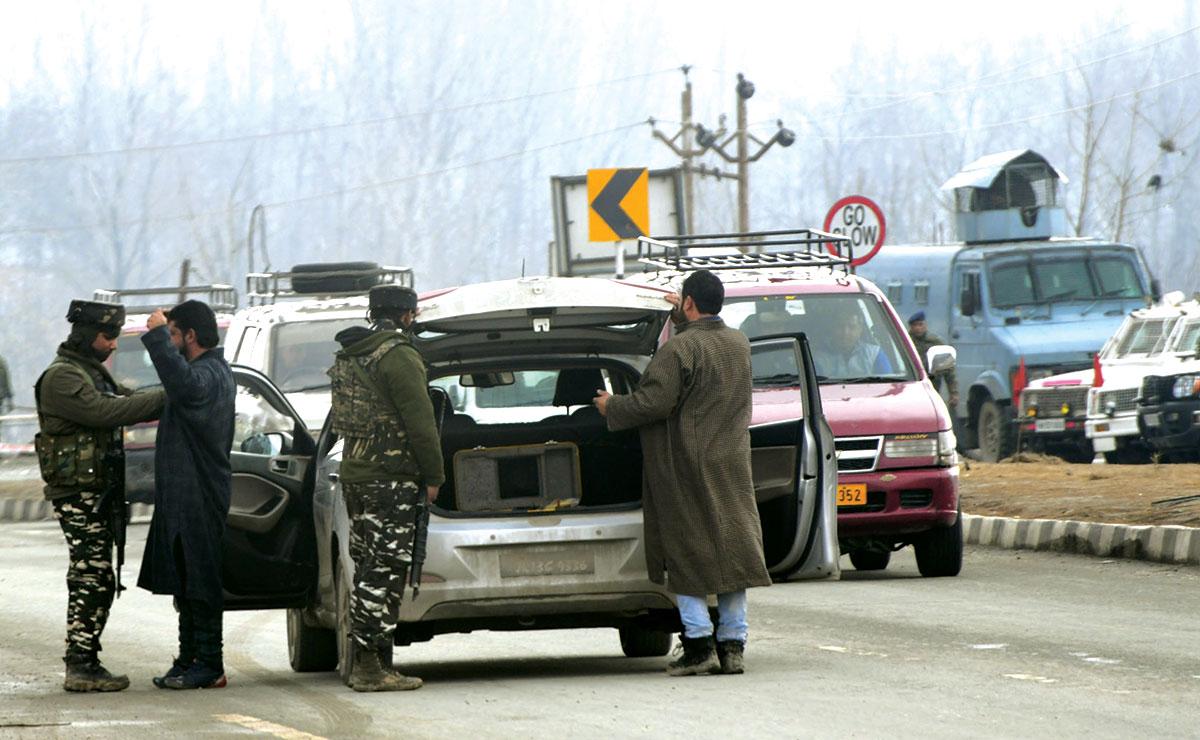
“It was also decided that the ministry of external affairs will “initiate” steps to ensure complete isolation of Pakistan among the global community for its continued support to terrorism,” Hindustan Times reported about the meeting. “The government has also called an all-party meet to discuss the matter with opposition parties on Saturday.”
“At this moment, there are expectations and the feelings of a strong response which is quite natural,” Modi said a public gathering after the CCSA meet. “We have given full freedom to the security forces.” Insisting the security forces will choose the time and location of their choice while asserting that “the terror outfits and those aiding and abetting them would have to pay a very heavy price for their actions”.
Holding Pakistan responsible for the attack, Prime Minister said India’s “already isolated” member is in “a state of illusion”; if it thinks that such attacks can demoralize India. “Let me state categorically that it should stop daydreaming to destabilize India,” Modi said. This neighbour of ours which is in a state of economic despair must know that any such attempt is destined to fail and will be foiled.”
In Srinagar, Singh told reporters that a plan is being reviewed and no civilian traffic will be permitted when convoys are moving. Conveying his happiness that “Kashmir and Jammu are with the centre in the fight against the terror”, the visiting minister directed a review of the security of the persons who are funded by Pakistan for their “involvement in terror conspiracies”. He said he has issued directions to handle sternly the elements attempting communal tensions.
A serious situation had emerged by the time Home Minister said the elements disturbing peace would be handled. During the Jammu bandh that the Jammu Chamber of Commerce and Industry had sponsored, surcharged young men resorted to bouts of violence in the capital city and attacked Kashmiris. A number of cars were destroyed and threats were issued.
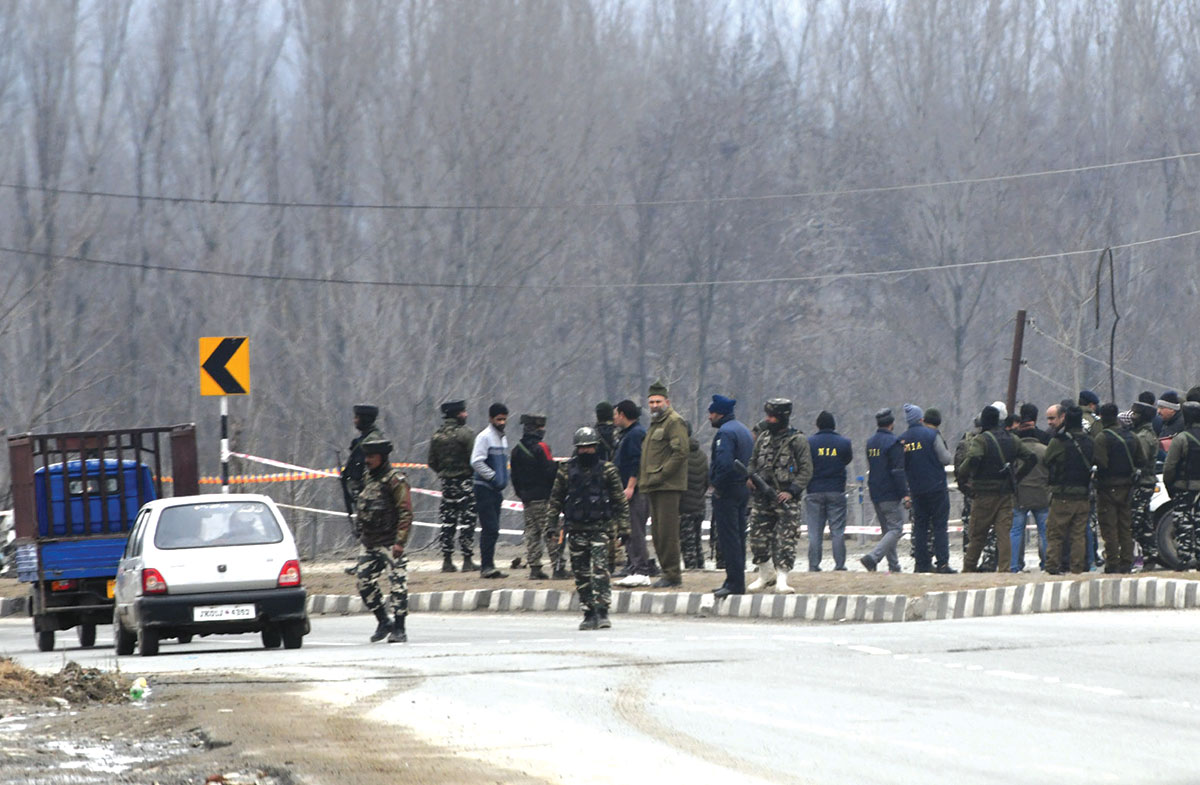
A vast section of the Kashmir society spends most of the winter in Jammu, partly because of their winter-deployment and partly because they have built second homes there. The authorities addressed the insecurity by imposing curfew restrictions. Tensions, however, remain, especially at a time when the state of the highway to Srinagar is unstable because of weather conditions. The road opened almost a week after it remained closed.
But Kashmir, that is dumbfounded by the Lethpora attack, is concerned about more than half a million people who are in the Indian plains for education, trade or simply on winter vacations. A number of students have already been booked for positively responding to the car bomb attack.
Right now, this is the major concern for the Kashmir political parties. “Distressed to hear about miscreants in Jammu trying to take advantage of the situation by inciting tension. Guv adm should have pre-empted this by securing minority-dominated areas,” Mehbooba Mufti, the PDP leader who failed coalition with BJP is blamed for part of the mess the state is in. “It will be a travesty & against the spirit of our secular ethnocultural values to use this terror attack as an excuse to target minorities. Hour of the need is to show compassion & come together.”
Omar Abdullah remained busy responding to the crisis that Jammu and Kashmir landed after the attack. “It should never have been allowed to reach this point. Pre-emptive measures should have been taken this morning knowing that it is Friday & congregations would assemble for prayers,” Omar wrote on Twitter. This came after he talked to the authorities that deployed a few columns of the armed forces in Jammu’s most sensitive belts. He requested the visiting Home Minister to “please issue directions to all state governments to take special care in areas/colleges/institutions where Kashmiris are residing/studying. They are soft targets in a surcharged atmosphere.”
But everywhere – from TV screens to the political class, there are war cries. Delhi withdrew the most favoured nation (MFN) status to Pakistan (the bilateral trade is barely the US $2billion) amid reports that the symbolic barter trade that is taking places at two places at Line of Control (LoC) for the last one decade may be closed. The two countries are already busy in the cold war diplomacy envisaging summoning the diplomats for conveying terse messages to each other. India has summoned its Pakistan envoy to Delhi for consultations, within less than 24 hours after the attack. Officially, Pakistan has denied its involvement.
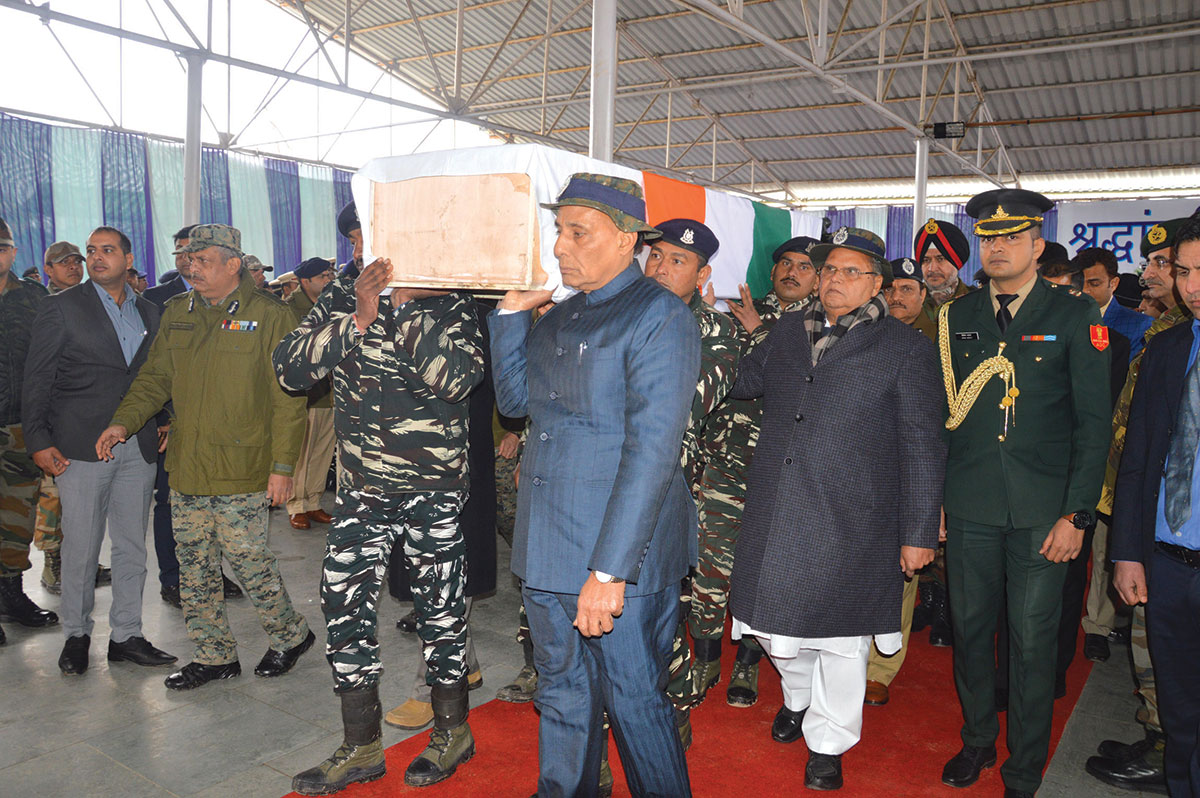
A war between two nuclear neighbours could prove disastrous but the war cries are in the air. These are expected to get louder once the coffins fly home across various Indian states.
Washington Post quoted strategic Affairs expert and a professor of international relations at JNU, saying, “It is only a matter of time before India reacts militarily”. Options, he said, could be to “repeat the type of strikes it conducted in 2016 against militant camps in Pakistani territory” or launch a “fire assault,” involving “increased firing of heavy artillery across the line of control that divides Kashmir”. So far LoC is tense but calm.
“With national elections in India set to take place by May and Prime Minister Narendra Modi facing a close contest, analysts say he risks looking weak if he does not respond,” New York Times reported. But the step risks “a cycle of escalation which you’re not sure you can control or manage,” former NSA Shivshankar Menon told the Washington Post.
But this is not for the first time that a JeM attack brought India and Pakistan closer to war. Last time, it was the attack on the Parliament that forced the then Prime Minister Atal Behari Vajpayee to order fast forward movement to the troops under the Operation Parakaram. A much earlier high profile incident involved the hijacking of an Air India aircraft from Nepal that eventually led to the barter of the outfit’s founder with the release of the aircraft and its passengers at Kandahar in Taliban controlled Afghanistan.
Even during the initial days of Modi’s takeover as the Prime Minister, the outfit was held responsible for the attack in Pathankot. Now came the Lethpora attack, amid reports that the counter-insurgency grid has reduced it in size and impact.
Right now, the debate in the security circles is that if at all the attack was a security failure. “Militants managing such a huge quantum of explosives in heart of Kashmir and nobody has a whip,” a former minister said. Incidentally, the attack came a day after the governor’s administration order a major reshuffle in the police administration that included at least two district heads from the restive south Kashmir region.
But the state police intelligence organisation insists they had the input and that was shared with the entire security grid. They had detected a Jaish video uploaded on social media that showcased an Afghanistan car bomb. The “extremely urgent” advisory was issued on February 9, almost 10 days ahead of the attack. nevertheless, the CRPF decided to move 2547 personnel in a single convoy.
The issue will now be part of the wider investigations that possibly NIA will preside over. Already, reports in the media suggest that seven persons have been rounded up for questioning.
But the history of the last 30 years suggests that the Lethpora attack was the biggest of all the car attacks that rebels mounted. Earlier, worst car bomb explosion took place when a non-local JeM militant rammed a hijacked BSNL vehicle with the main gate of the old state legislative complex on October 1, 2001, killing 38 people.
In 2005, alone 36 people, including 12 soldiers, were killed in six car bomb attacks. On August 10, 2000, car bomb attack 12 people were killed near Srinagar’s busy State Bank of India. The trend had started on April 19, 2000, when Afaq Ahmad Shah, 20, a JeM recruit, blasted himself in a car outside the 15 Corps Headquarters in Srinagar. Later, on December 25, 2000, JeM drove Birmingham (UK) militant Abdullah Bhai to the 15-Corps Headquarters where he killed himself in a car bomb with over a dozen soldiers.
In November 2005, a few hours before the swearing in of Ghulam Nabi Azad as the Chief Minister of Jammu and Kashmir, a car bomb, took place at Nowgam killing at least 10 people and injuring 18 others.

Militants have used IED and landmines as a major tool against the counter-insurgent grid. One of the worst attacks took place on July 19, 2008, at Narbalin city outskirts that killed 22 soldiers. They also were part of a long Srinagar bound convoy from north Kashmir.
Over the years in Kashmir, the counter-insurgency had emerged into a vast super-structure with a lot of legal and physical infrastructure. Though the number of militant organisations has gone down to a few, the number of militants goes up and down. “It waxes and wanes,” one police officer explained. “The number goes down once it exceeds a particular number that space is not able to sustain.” In 2018, official records suggest, a total of 257 militants and 91 counter-insurgent forces personnel were killed. In the last decade, 2018 was the deadliest year. The year 2019 has not proved any different. It was in the backdrop of this, the IAS 2008 topper, who resigned the coveted service and joined politics, said: “It is Karbala on daily basis. One side mourns today and another mourns tomorrow.”















